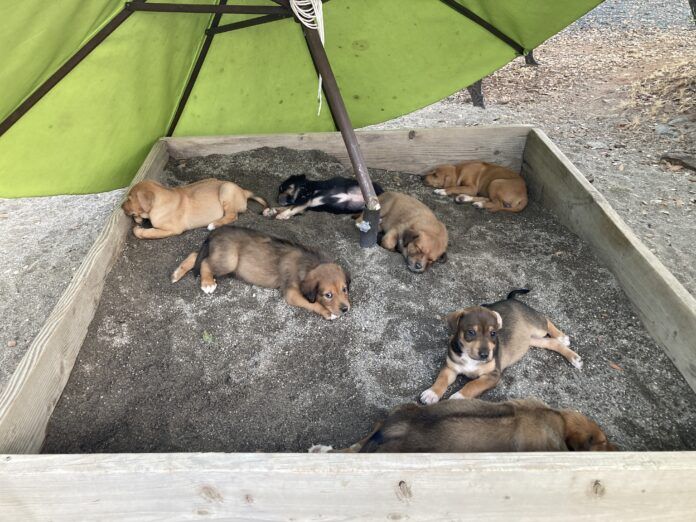
Whether or not the dog DNA tests that purport to reveal the breeds that have gone into your mixed-breed dog are accurate, they are fascinating.
Late last summer, I fostered a medium-sized dog who was, according to her owner, a mix of Rhodesian Ridgeback and Australian Shepherd. Luna had a crazy pattern of backward-growing hair and tight swirls down her back, in a violin-shaped pattern – but neither her size, shape, or coat color looked particularly like a Rhodesian Ridgeback. And certainly nothing about her resembled an Aussie in any way.
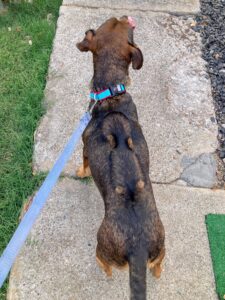
Luna’s seven puppies were a further mystery. Since she had belonged to a man who was homeless, and she frequently wandered around town without him, the pups she had may have had any number or type of fathers.
After the pups were spayed or neutered, I was thrilled to be able to find homes for all of them with friends or friends of friends (Luna got spayed and returned to her owner). And several of the new puppy owners had mixed-breed dog DNA tests done on their pups.
Of all the pups, Rocket looked the most like his mama, down to her identical color, short coat, and crazy, violin-shaped ridge. His owners were the first to have his DNA done – and so the first to be surprised by the findings! These results are from the Embark dog DNA test:

24.9% Australian Shepherd
23.4% Collie
19.5% American Pit Bull Terrier
12.4% Labrador Retriever
8.1% American Staffordshire Terrier
6.5% Golden Retriever
5.2% Rhodesian Ridgeback
This finding lent some credence to Luna’s owner’s claim that Luna was part Australian Shepherd, even though she looked nothing like one. The bully breeds (American Pit Bull Terrier and American Staffordshire Terrier) were not a surprise; almost every dog I’ve known who is from this area and has been tested (including my two disparate-looking dogs) has contained one or the other (or both) of these two ubiquitous breeds. But the presence of Collie was one surprise, mostly because none of the pups looked at all like Collies at the age of 12 weeks or so, when they got adopted. The other surprise was the low contribution of Rhodesian Ridgeback! Such a funny result, given the strong presence of the ridges on the pups.
Dashi was the next pup whose results came back. He was one of the only pups to lack a ridge down his back, and he had a thick, longer coat. He also has big, floppy, unattached dewclaws on his hind feet. I was sort of expecting a little Great Pyrenees in his breed DNA test results; I thought it was even possible he had a different dad than the rest of the pups. His results were from Wisdom Panel.
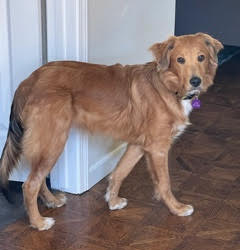
22% Collie
18% Australian Shepherd
17% Labrador Retriever
14% American Staffordshire Terrier
10% American Pit Bull Terrier
7% Golden Retriever
3% Miniature American Shepherd
3% Rhodesian Ridgeback
2% Boxer
2% Chow Chow
2% Shetland Sheepdog
Holy smokes! Collie and Aussie at the top of the charts again! And all the same breeds as found in Rocket, in slightly different amounts – and with some unusual other breeds thrown in. And again, with such a low contribution of Ridgeback!
I forwarded these results to the owners of the other pups, and asked if anyone else had ordered DNA tests for their pups. The folks who adopted one of the pups who looked the most like a purebred Ridgeback had ordered tests from both Embark and Wisdom Panel – my kind of people! (I, too, have results from both companies for both of my dogs.) Astra is the color of a Rhodesian Ridgeback, has the right kind of coat, and has a prominent ridge.
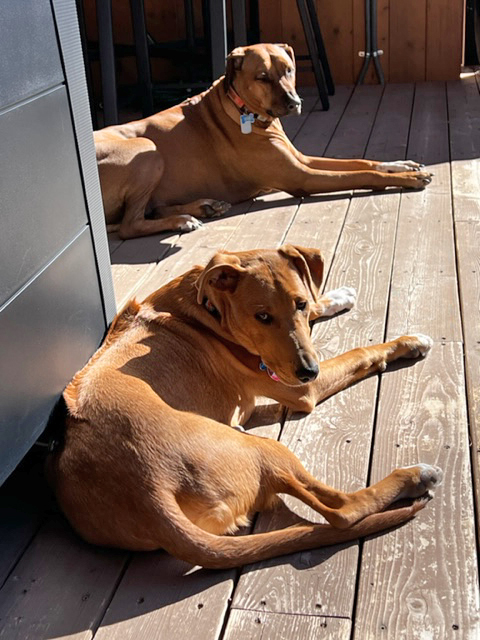
Wisdom Panel DNA Test
24% Collie
19% American Staffordshire Terrier
18% Australian Shepherd
11% Labrador Retriever
10% American Pit Bull Terrier
5% Golden Retriever
4% Miniature American Shepherd
3% Rhodesian Ridgeback
2% Chow Chow
2% Shetland Sheepdog
1% Boxer
1% Chesapeake Bay Retriever
Embark DNA Test
26.6% American Pit Bull Terrier
24.9 Australian Shepherd
21.4% Collie
12.4% Labrador Retriever
10% American Staffordshire Terrier
4.7% Golden Retriever
So interesting that the two different dog breed DNA testing companies found similar breed contributions, but interpreted the amounts of the breeds so differently. Embark seemed to identify American Pit Bull Terrier as the dominant bully-breed contributor in its two tests of the siblings, and the American Staffordshire Terrier as playing a more minor role; Wisdom Panel had these roles reversed in its two tests. Embark also indicated that the pups had more Aussie than Collie in them; Wisdom Panel put Collie over Aussie.
Curiously, the company that found the most Ridgeback in any of the pups (Embark, with 5.2% in Rocket) found no Ridgeback inheritance in the pup who looks most like a Ridgeback (Astra)!
These tests may be scientific, but it’s imperfect science. Based on the commonalities between these four tests on three sibling pups, I’d say both companies are definitely getting at the contributing breeds, but I wouldn’t hang my hat on the percentages.
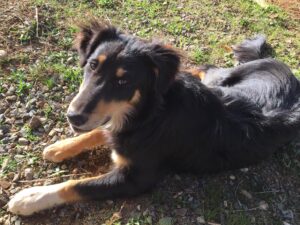
And, for what it’s worth, when the pups were with me, I didn’t see any Collie looks whatsoever. But now that they are about 9 months old, several of them look very similar to Collies! I was dubious about the results months ago, but now I’m sold. One puppy, Gabby, belongs to my ex-in-laws. She has very strong Collie looks – with a gorgeous, long, tri-color coat – and a crazy ridge down her back!


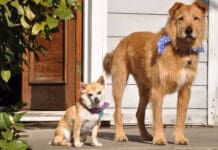
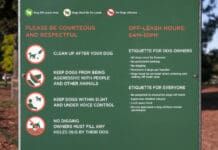
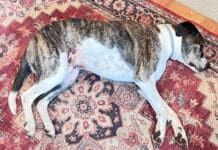

Wisdom Panel, whom I had sent a photo and told where he was from, said my dog was Canaan, Basenji and Border Terrier mix. I then sent no info to Embark and results said 100% South Asian Village Dog, and he is a village dog from Southern India.
DNA results and how the dogs look are definitely interesting. I have a dog that the rescue thought was at least 1/2 Bearded collie. We saw the mother and she looked kind of like a Bearded collie. Our Skye has mottled grey/black/white fur, but it is somewhat long and wiry and she has a beard and ears that can go down or prick up. But she always had some strong protective instincts and stubbornness that seemed like another breed. I finally (after 13 years!) did an Embark DNA. She’s mostly Cattle Dog with Great Pyrenees as the next highest percentage. Then other herding breeds and a tiny bit of husky and chow. Not a drop of Beardie blood in her. I asked them to rerun it to be sure. Now that I’ve let go of the Bearded collie identity I thought she had for so long, I can see the input of the breeds they identified.
Try Wisdom. I think they are a bit more accurate.
I had a golden checked by embark they said she was 50% pug. What a joke! I had seen her
whole litter and her parents. She looked and acted like a golden. I had her for many years.
I do not believe the genetic panels at all anymore
They have for sure gotten better over time. Results from my dog Otto’s first tests, done over 10 years ago, were ridiculous and sublime. But the most recent tests, from about five years ago, made more sense – and the two companies concurred about what was “in the mix,” though, again, they disagreed on the percentages. See https://www.whole-dog-journal.com/blog/mixed-results-researching-your-dogs-dna/
Interestingly, Embark and Wisdom Panel disagree about which bully breed predominates in my dog Woody (just as with the pups described in this post). https://www.whole-dog-journal.com/blog/dna-tests-for-dogs-fun-interesting-but-probably-not-worth-the-money/
I have been skeptical for years on the DNA testing. I agree with you. And unfortunately for dog owners I’m not 100% sure DNA testing on dogs can be accurate?
I think the results depend a great deal on the DNA database the company uses for comparisons. Also, the results seem to reflect a false degree of precision. For humans trying to track down their ancestry via DNA, that’s certainly true. It’s generally thought that one of the big genealogy companies has a better database for identifying Ashkenazi Jews, for example. With the pups, it’s fun, but is it science?
I do not believe the genetic panels regardless of which company does them.
I find running a DNA panel to be a fun way to speculate about my dog’s heritage. My current pup has a strong build with a long body but very short legs. Embark said he’s Lab/Am Staff/Chihuahua with some terrier/min schnauzer mixed in. I found with a previous dog that I got very different results from two companies, with Embark seeming to make more intuitive sense.
Several of my pup’s littermates have DNA panels too. Embark & Wisdom. If you read the results like Kim Brophey (Meet Your Dog), they match. They all said 1/3 Rottweiler x 1/3 herding mix x 1/3 hunting mix. The details aren’t very important. 🙂
I would like to see the results obtained by the reputable breeders of different purebreds. WDJ has consistently failed to do any control testing of these genetic breed panels by doing this. I think these panels are far more reliable for genetic conditions than determining breed heritage.
If the basic assumptions that produce the data are flawed, then all that flows from them will also be flawed. That two programs can have such diverse results seems proof this is so.
Wisdom Panel has recently ‘improved’ its breed analysis, but IMO, they went backwards as the new results are clearly inaccurate.
I think these panels may be useful in cases where genetic makeup is important to know but difficult to determine such as selecting rescued dogs for specific work. I take the results with a grain of salt: like hydraulic computer models, they represent a ‘best guess’ effort.
DNA analysis is a new and evolving science for both humans and dogs. So results should be taken with the proverbial “grain of salt.” But another major factor is that genotype (genetic makeup) and phenotype (appearance) are not consistent, accounting for individual traits in closely related individuals.
If this were not the case all siblings would be identical twins since they share the same DNA. Gene expression, which accounts for differences, is far more complex and not well understood by geneticists. Breeders of pure breed dogs who have repeated matings of the same sire and dam know that the litters produced may or may not be consistent in many traits, and mixed breed dogs with very similar DNA profiles can appear quite different from each other.
The true paradox is that in the long view of anthropology, all mixed breeds were once pure (small indigenous packs of wild dogs) and all pure breeds were once mixed (selectively bred by humans in the last couple of centuries to produce specific traits.)
You can’t really comment on “long slender faces” on dogs who were de-sexed so young. There is a striking difference in how they grow and appear, even if you know they’re, say, 100% golden retriever. Long legs and narrow back skull and chests are typical, and sometimes the face only appears longer than a dog with a broader backskull. The straight angles, which increase the risk of both dysplasia and cranial cruciate ligament rupture or tears, also affect the dog’s overall appearance and balance. And risk of bone cancer, too, sadly. I kind of understand why rescues stick with it, but pediatric spay neuter (and arguably de-sexing full stop) are really terrible for individual dogs, especially of larger breeds. You can’t “alter” the dog without affecting every part of its being. You can sterilize them, though, without de-sexing.
VERY good point!
100% agree!! “Dashi (center left, looking at camera) was a chunky puppy, but he’s one of the most refined pups now” – that’s very common with pediatric spay/neuters. We see it in my breed as well – much taller, slab sided, lite boned puppies that started out stocky and round. Often you can tell when a pure bred was sterilized at 6 mos or younger just by looking at them. A question I have – when you send in the DNA, do you have to include a photo as well? Just wondering how much that could influence the outcome…
I’ve done 7 DNA tests. Never once sent a photo. All results seemed not only plausible but explained some of the behavioral tendencies I was seeing. Fun!
Actually, the test really should be SCIENTIFIC because there should be specific alleles for specific breeds for which specific DNA primers have been made to identify these specific alleles. Period. When I used one of these companies several years ago for my rescue pup the company (I don’t recall which company) sent me a questionnaire asking me coat color, eye color, size, etc. and even wanted me to send a picture. I told them that it was their job to tell me color, etc. Obviously, they wanted the info and picture so that they could manufacture the genotype to fit the phenotype. How fraudulent is that? Maybe don’t waste your money. It would be a good follow-up research article for WDJ to send in known DNA samples to these different companies to root out any fraud, incompetence and/or lies. Either they can make genetic determinations for various breeds or they cannot and at least they owe the customer transparency on their limitations.
I’ve only had one of my dogs tested, and I was blown away by the accuracy of the results. I used Wisdom Panel Premium, and to be fair, already knew my pup’s breed. I got him from a local shelter, but he is clearly a purebred Rough Collie. I did the full Premium package because I wanted to know if he had the MDR1 mutation and wanted to know if CEA was something to be aware of in the future (and figured ‘why not?’ on all the others since I didn’t know anything about his history). I sent them nothing but his name and the cheek swab. The results came back 100% Collie, and included a genetic analysis of his physical characteristics, which were remarkably spot-on, from the Tri Color pattern to significant white on his coat. My boy has a Tri color head and a mostly white body with a splash of black across each flank, so he doesn’t have a terribly common coat coloration. The best news of all, of course, is that the health checks came back clear!
What is the name of the company for which you speak so highly? Thanks
Good read who would be the best company to do DNA TESTING?
The only way to determine which companies are the “best” would be to send samples from mixed-breed dogs of reliably known parentage (purebreds or dogs who are the products of purebreds) to both companies. It would be prohibitively expensive for us to do that, unfortunately.
And in my experience, the less “mixed” a dog is, the more likely it is that both companies get it right. If a pup is a result of a purebred and another purebred, they always get the breeds in “the mix” correct. And if a dog is VERY mixed, like my Otto, then the differences in the results from company to company are sort of to be expected. I’m feeling reasonably confident that the results are pretty good from both companies, at least in terms of the major breeds. Some of the ones returned at a 1% or 2% contribution, I wouldn’t hang my hat on.
I did DNA years ago on my 100 pound, dark gray, long haired dog and it came back German Shepard and dachshund. Didn’t believe it for a minute.
Can you please name the company that you used? This article and the comments are only informative if we get specific. Name the companies.
Our mixed breed rescue of unknown history looks like an English Pointer in coloring and coat type, with a distinctly Staffie ear type and sometimes facial expressions, a “smear” of Border Collie like coloring on her face, and a Pittie looking butt. She is extremely nose driven and has a high prey drive. Her play behavior out in an open area with other humans and dogs brings out distinctly Border Collie-like traits, such as bossy barking, and a belly drop and watch when pursuing a running playmate. Embark results put her at about 1/4 APBT and 1/4 Border Collie, with the rest as German Shepherd, Bulldog, and what they call “Supermutt”, and no sign of Pointer whatsoever. The Pittie and Border Collie combo can totally explain so many things, and if put together they can explain how the coloring (Border Collie) and coat type (just a little longer than APBT) makes her look like a Pointer. So I am fairly satisfied with these results. I’m pretty sure if I suggested to my husband that we do a Wisdom Panel too, he would draw the line at spending any more on this question. He remains convinced there is also Pointer in her, so who knows what Wisdom might find?
Our mixed breed puppy was tested by Wisdom and a sibling was tested by Embark – we know they had the same parents. The results had some overlap but were substantially different. From the perspective of our guesses, they match up more along the Embark results. However, the Wisdom test provided some significant genetic health markers of concern that Embark did not provide. This was critical to helping one of of the other siblings get properly diagnosed for a rare blood disorder. Several months later, Wisdom updated us on a change in the testing protocol which changed the order of breed results. We appreciated the information from both services, even if they breed information was not perfectly correct.
Miniature American Shepherd wasn’t even recognized as a breed until about 7 years ago. Chow seems to show up in a disproportionate number of results. I’d be wary of making heath care decisions based on the analysis by these companies. Why de-sex at such a young age with known negative consequence associated this this procedure?
I had my Freyja Grey tested with Embark when I got her because I was convinced she was a Keeshond mix, not a Husky mix the shelter labeled her with. But she came back 55% Husky and 12% Border Collie, plus some other breeds.
I wasn’t convinced because at the time I had no idea what Agouti coloring was. (It’s wild wolf.) So I did a second test with Wisdom Panel. That still identified her as primarily Husky with Border Collie as a secondary but many more small percentages of breeds that Embark either ignored or lumped in with the primaries. I also like the way that Wisdom groups them into Herding, Working, Asiatic, etc.
So now I’m convinced she is a Husky mix and I’ve learned what agouti is. I call her my little wolf, my granite fox and my little Togo.
Embark:
55.4% Siberian Husky
12.9% Border Collie
8.1% Chow Chow
6.3% German Shepherd Dog
5.1% Boxer
4.2% Samoyed
8% Supermutt:
Akita
Rottweiler
Wisdom:
54% Siberian Husky
9% Border Collie
5% Chow Chow
5% Jindo
4% Boxer
3% Akita
3% Samoyed
3% Alaskan Malamute
3% Australian Cattle Dog
2% Chinese Shar-Pei
2% German Shepherd Dog
2% Rottweiler
2% Cocker Spaniel
2% Golden Retriever
1% Australian Shepherd
“This gene is responsible for causing different coat patterns. It only affects the fur of dogs that do not have ee at the E (Extension) Locus and do have kyky at the K (Dominant Black) Locus. It controls switching between black and red pigment in hair cells, which means that it can cause a dog to have hairs that have sections of black and sections of red/cream, or hairs with different colors on different parts of the dog’s body. Sable or Fawn dogs have a mostly or entirely red coat with some interspersed black hairs. Agouti or Wolf Sable dogs have red hairs with black tips, mostly on their head and back.”
Dark or Light fur: EE (MC1R)
Dark Brown PIgment: NN (HPS3)
Red PIgment intensity: dilute red
Brown or Black pigment: Bb (TYRP1)
Color Dilution: DD (MLPH)
Hidden Patterning: kyky (CBD103)
Body Pattern: ayaw = Agouti (ASIP)
Facial pattern: EE (MC1R)
Saddle Tan: NI (RALY)
White Spotting: Ssp (MITF)
Roan: rr (USH2A)
Merle: mm (PMEL)
Harlequin: hh (PSMB)
I love this place